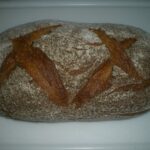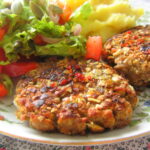Table of Contents
TogglePfefferbrot (Pepper Bread)
Introduction
Pfefferbrot is a distinctive bread where the warmth of pepper blends with the richness of traditional bread ingredients. Originating from European culinary traditions, this bread is known for its unique spiciness and robust flavor. This recipe will guide you through crafting this flavorful bread, making it an exciting addition to your baking repertoire.
Ingredients
- Bread Flour: 500 grams, for a strong, elastic dough.
- Whole Wheat Flour: 100 grams, to add texture and a nutty flavor.
- Active Dry Yeast: 7 grams (or 20 grams of fresh yeast), for leavening.
- Warm Water: 300 ml, to hydrate the yeast and dough.
- Molasses or Dark Brown Sugar: 2 tablespoons, for a hint of sweetness.
- Butter: 50 grams, softened, for richness.
- Freshly Ground Black Pepper: 2 teaspoons, adjust to taste.
- Salt: 10 grams, to balance the flavors.
- Caraway Seeds: 1 teaspoon, optional, for an additional layer of flavor.
Equipment
- Large mixing bowl
- Dough scraper or spatula
- Kitchen scale
- Bread loaf pan or baking sheet
- Oven
- Kitchen towel or plastic wrap
Preparation
- Activating the Yeast: In a small bowl, dissolve the yeast in warm water. Add a pinch of sugar or flour and let it sit for about 10 minutes, until frothy.
- Mixing the Dough: In a large mixing bowl, combine both flours, salt, pepper, and caraway seeds (if using). Add the molasses or brown sugar, activated yeast mixture, and softened butter. Mix to form a shaggy dough.
- Kneading: Turn the dough onto a lightly floured surface and knead for about 10-15 minutes, until smooth and elastic. The dough should be soft but not overly sticky. Adjust with a little more flour or water if necessary.
- First Rise: Place the dough in a lightly oiled bowl, cover with a kitchen towel or plastic wrap, and let it rise in a warm place for about 1-2 hours, or until doubled in size.
- Shaping the Loaf: Punch down the risen dough to release air bubbles. Shape it into a loaf and place it in a greased loaf pan or on a lined baking sheet for a free-form loaf.
- Second Rise: Cover the shaped dough and let it rise for another 45-60 minutes, until puffy and nearly doubled.
- Preheating the Oven: Preheat your oven to 220°C (425°F) about 30 minutes before you plan to bake.
- Baking: Score the top of the loaf with a sharp knife or lame, then place it in the oven. Bake for about 30-35 minutes, or until the crust is golden brown and the loaf sounds hollow when tapped on the bottom.
- Cooling: Remove the bread from the oven and let it cool on a wire rack for at least an hour before slicing. This rest time allows the flavors to meld and the crumb to set.
Tips for Success
- Pepper Quantity: The amount of pepper can be adjusted based on your preference for spiciness. Freshly ground black pepper is recommended for the best flavor.
- Kneading: Proper kneading is crucial for gluten development. The dough should be tacky but not overly sticky.
- Proofing: Ensure the dough is adequately proofed during both rises. Under-proofed bread will not have the right texture or flavor.
- Scoring the Bread: A deep score helps the bread expand evenly during baking.
Serving Suggestions
Pfefferbrot can be served with a variety of spreads and toppings. It pairs exceptionally well with creamy cheeses, cold cuts, and can even be used for a spicy twist on traditional sandwiches. Its bold flavor also makes it a great accompaniment to soups and stews.
Conclusion
Baking Pfefferbrot is a delightful experience, offering a unique twist on traditional bread. The blend of peppery heat with the rich, hearty texture of the bread makes it a memorable addition to any meal. Enjoy the process and the delicious results!


